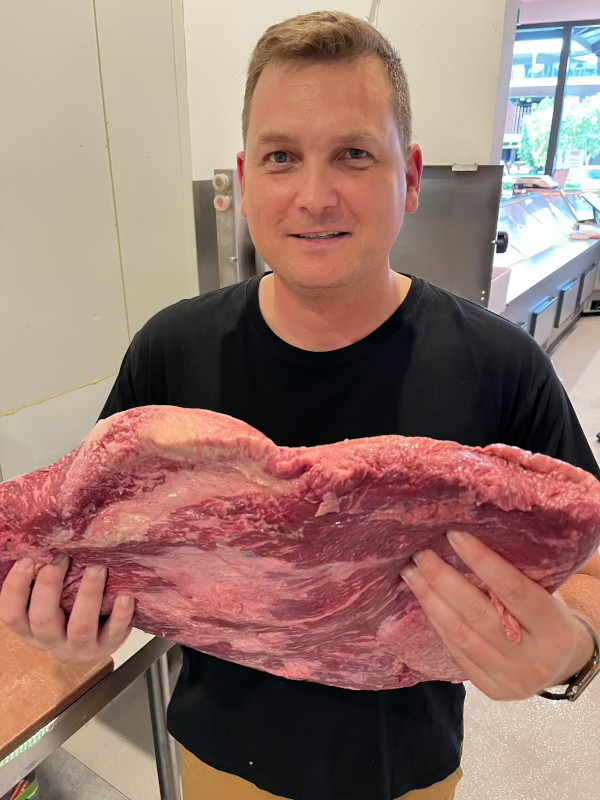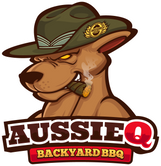How to smoke a brisket
Mastering the art of cooking brisket is like unlocking the pinnacle of BBQ perfection, marking a significant achievement for any pitmaster. Although there are numerous flavoring techniques for brisket, achieving the perfect cook requires precision and consistency. Due to its tough nature, brisket demands a slow and steady approach to tenderize it properly. When cooked to perfection on a pellet smoker, offset or charcoal the brisket emerges tender, succulent, and utterly irresistible.
To brine or not to brine, that is the question.
The school of thought behind brining steaks is very much in favour of yes, so why not brine briskets too? I have found that seasoning the brisket the night before (uncovered) helps form pellicle or the darker and firmer coloured meat you would often see in hanging meat in the butcher. This then makes way for a better bark on the brisket at the end of the cook.
Continue reading to discover the secrets of smoking brisket like a seasoned pro!

Flat muscle of a brisket for Competition barbecue practice
- beef /
- brisket /
- gym /
- how to guide /
- how to smoke a brisket /
- protein /
- smoked brisket /
- wood smoked
Beginners Guide How To Smoke a Brisket (oven/smoker/gas bbq)
Rated 5.0 stars by 1 users
Category
Main
Cuisine
American
Author:
John Austin from AUSSIEQ BBQ
Servings
10-15
Prep Time
30 minutes
Cook Time
12 hours
Calories
155
Rest Time
6 hours
When cooking a large brisket, it’s important to select a well-trimmed, well marbled cut of meat, as fat aka marbling (intra-muscular fat) can provide a better brisket. Selecting the best brisket possible can save you money, but arguably more time in your pocket. If you go through all of the briskets at your local butcher or supermarket there can be a vast difference between them and all for the same price. If you select a brisket with an even, thick flat end and an even thin fat cap there will be less trim. The only downside is less meat trimmings is less mince you can make with it.
The price of a decent brisket is very subjective, but in Australia you will expect to pay between $10-18 per kilo. With wagyu briskets ranging from $18-30 per kilo.

Ingredients
-
5-10 kg full packer beef brisket
-
Backyard BBQ Rub
-
Oz Dirt BBQ Rub
-
5 tbsp Siracha sauce for binder
Directions
SELECTION
The old man floppy test. Source a floppy and bendy brisket like an old man’s you know what. If it bends freely and has a lot of give in the brisket, this can indicate you will achieve a tender end result.

Marbling and fat cap. Look at the flat of the brisket and if it has good marbling, you are onto a winner. Lastly, look for a soft and thin fat cap. The thicker it is the more you have to trim off.
Thickness. Generally the part of a brisket that dries out is the flat as it’s the leanest and thinnest. Look for a brisket with a thick and consistent flat end.
PREP
The goal is to make it aerodynamic and to get a good bite from all parts of the brisket with little cooked wastage.
To smooth out the brisket and remove all the flappy bits we want to slice down the long ends of the brisket first. From there round off both ends. Paying particular attention to the flat end so if it is quite thin, that part is removed so it is more consistent. All of this will reduce pieces overcooking and burning up during the cook.

Now you will shave the fat cap on the upper side of the brisket so there is approx 1cm of fat across the top. Don’t get to crazy here, as long as its approximate and you can push on the fat cap and it should feel soft and pliable. If you have a heavily marbled piece of brisket you can take most if not all fat from the point or thicker end as it has more intra-muscular fat to help stop it drying out. The fat cap is generally left on the flat end because it’s much leaner and has a tendency to dry out if overcooked.
What to do with leftover fat? With all the trimmed fat, add it to a small cast iron pot or heat proof container, then that will be rendered down during the cook to make tallow.
Seasoning and brining. The night before you commence cooking start your prep which importantly includes seasoning. Seasoning the night before the cook not only saves time on the day of the cook, but serves to brine the brisket.
Use a 50/50 blend of Backyard BBQ and Oz Dirt rub for a well balanced coffee, earthy, smokey and slightly citrus flavour. The key for quantity of seasoning lies within the thickness of the brisket. I first cover the brisket with enough seasoning so you can only just see the red colour of the meat or white of the fat. **remember, if you are going to eat all sides, season all sides. If you have a particularly thick point end, I would double the seasoning on that end. Once seasoned, bang it into the fridge uncovered.
Binder. Before you hit the brisket with seasoning it is advantageous to apply an even coat of a binder like Sriracha sauce. Through my testing I have found that approx 10% more seasoning sticks to the meat with binder, and if you go heavy enough you can add to the flavour profile. A thin even coat of Sriracha so you can just see it will work a charm.

COOKING / SMOKING PHASE
Fire Up The Barby. Throughout the duration of the cook you want a clean, blue smoke. Why you ask? Because if the smoke is billowing white aka dirty you can be left with a bitter and acrid tasting piece of meat at the end. Whether you're smoking on a pellet, wood, gas or charcoal smoker I like to preheat the smoker until you reach approx 250F/121C and the smoke is near invisible with a slight blue tinge. For charcoal and wood smoker - Once you gain more experience you can add a cherry wood branch for example on the coolest part of your firebox to layer some additional smoke into the cook.
Now that the smoker is preheated, you can remove the brisket from the fridge and place it onto your grill grate of the smoker. If you are a data nerd like me, place a temp probe in the point end, flat end and one for ambient pit temp. Once you get the head of cooking briskets you won’t need a thermometer for most, if not all of the cook.

Unless something goes drastically wrong you want to leave it alone for at least two hours before you take a gander at the brisket cooking away. If you are looking, it ain’t cooking!!
Fast forward approx 8 hours. During that time take a look every 1-2 hours and if an area of the brisket is starting to form a hot spot, place a pice of foil loosely over that area to equalise cooking.
To wrap aka Texas crutch. When the surface or bark of the brisket can be scratched and the rub doesn’t slide off and it has a dry appearance you can check the internal temp. At around 175°F or 74C, you can wrap the brisket in pink butchers paper, to speed up the cook and help preserve the existing moisture. It is at this stage that I will smear or pour some of the beef tallow over and around the brisket for flavour and better mouth feel.

Now bang it back on the smoker for approx 1-2 hours. The key here is to go off the feel of the brisket, not necessarily the internal temp. When you can push a temp probe or metal skewer through the flat and point end with little resistance it’s time to start resting your brisket.
FINISH HIM
Resting a brisket. Resting the brisket for a solid 6 hours is preferable. A great way to do this is set your oven to 65C and place the wrapped brisket inside. Ensure you open the wrap for ten mins before you place in the oven to tent it (allow steam and heat to escape to reduce the carryover cooking process). The point of a long hold in the oven is to help tenderise it as it cools slowly, and redistribute liquid in the wrap to parched areas of the brisket. Just be aware that the longer your rest it, the more chance the bark will soften. It is all a balancing act!
Slicing. Your hunk of meat has been smoked and rested to perfection, so it is now time to slice. There is a crap load ways to slice it, but this is my preferred way. Sometimes I will separate the flat and point by cutting it through the fat line.
1) slice from the outside of the flat towards the centre and stop where it meAts the point (white lines on example)
2) turn it 90 degrees and start slicing the opposite direction (green lines on example)
Hot tip: if you are going to slice as you serve, have the sliced meat side down on your cutting board so it doesn’t oxidise.

any crispy daggy bits can be chopped up and used in snag rolls aka sausage rolls.
Recipe Video
Recipe Note
Wrap Up Cheat Sheet
How to Smoke a Brisket:
1) Trim excess fat and flappy bits of meat off the brisket.
2) Apply a binder, then season with a heavy hand with salt and pepper or brisket rub blends mentioned above. Season the point end heavier as it's the thicker end of the brisket.
3) Put brisket on the smoker, baby etc at 120-135C or 250-275 °F.
4) Smoke for approx 6 hours until internal temperature is 76C or 170 °F. The rub on the brisket should pass the scratch and sniff test. Meaning you can scratch the surface and the rub won't slide off.
5) Wrap brisket in butcher paper or foil (Texas crutch) and return to the smoker.
6) Place the brisket back on the smoker until the internal temperate reaches 190°F or 87C. When you can push a metal skewer through the flat end and point end with little resistance it is cooked. If it's still tight, cook it out longer and probe every 20-30 mins until tender.
7) Remove the brisket from the smoker, then let it rest at least 2-6 hours before slicing.
8) Slice point end from the end towards to the point. Where the flat and and point meAt, then turn the brisket 90 degrees and slice the point. This is to cut against the grain
9) In total, smoking a brisket takes between 8-12 hours depending on the type of brisket eg wagyu cooks quicker
** have you heard that the left side brisket on cattle yields a better result than the right side, because they often get up off the ground favouring their right side. This stretched the muscles on the right side, making it a little tougher**
Nutrition
Nutrition
- Serving Size
- 1 serving (100g)
- per serving
- Calories
- 155
- Fat
- 7 grams
- 10%
- Protein
- 21 grams
- 42%
- Carbs
- 1 grams
- Cholesterol
- 62 milligrams
- 20%
- Iron
- milligrams
- 10%
- Potassium
- 330 milligrams
- 9%


